12 Best Native Plants for Pennsylvania
BY RELA CATUCOD | MAY 20TH, 2023 | LAWN CARE, PENNSYLVANIAThe Keystone State, renowned for its scenic Pocono Mountains and the Appalachian Plateau’s rolling hills, boasts a diverse array of native plants. These unique landscapes create a perfect backdrop for the eastern redbud, swamp milkweed, and cardinal flower. That’s why we’ve gathered a list of the best native plants for Pennsylvania gardens.
Embracing native plants in Pennsylvania has plenty of benefits, such as:
- Healthier soil and less erosion
- Homes for local wildlife
- A more diverse and stable ecosystem
- Low-maintenance landscaping options
- Strong resistance to pests and diseases
Choosing Pennsylvania native plants means you’ll create a vibrant, balanced ecosystem right in your backyard. If you’re ready to dive into the world of native plants, we’ve got some fantastic options for your yard.
In this article, we’ll cover:
- Eastern Redbud
- Pennsylvania Sedge
- Swamp Milkweed
- Virginia Bluebells
- Wild Bergamot
- Black-eyed Susan
- New England Aster
- Canada Goldenrod
- Cardinal Flower
- Heartleaf Foamflower
- Butterfly Milkweed
- Blazing Star
- How to Choose Native Plants for Your Pennsylvania Landscape
- FAQ About Pennsylvania Native Plants
- Where to Find Native Plants in Pennsylvania
12 Native Plants for Your Pennsylvania Yard
1. Eastern Redbud (Cercis canadensis)
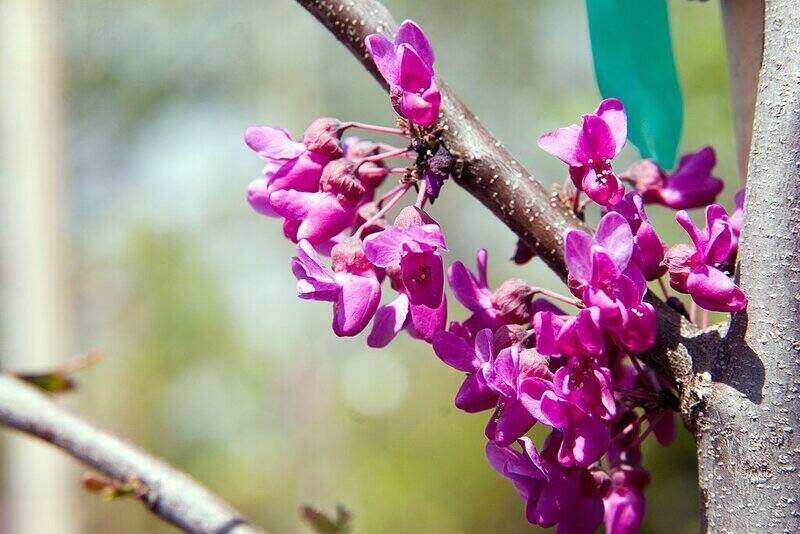
Photo Credit: David J. Stang / Wikimedia Commons / CC BY-SA 4.0
The eastern redbud, with its vibrant pink flowers blooming in early spring, is a stunning deciduous tree native to Southern Pennsylvania, such as Philadelphia and Delaware. This eye-catching tree offers homeowners a spectacular focal point in their gardens while supporting local ecosystems. As a bonus, the eastern redbud’s blossoms also attract pollinators, particularly bumble bees, enhancing the beauty and vitality of any Pennsylvanian outdoor space.
Plant type: Tree
USDA Hardiness Zone: 4 to 9
Sun: Full sun to partial shade
Soil: Adaptable to various soil types; prefers moist, well-drained soil
Duration: Deciduous
Bloom time: March to May
Water needs: Low
Mature height: 20 to 30 feet tall
Maintenance: Low
2. Pennsylvania Sedge (Carex pensylvanica)
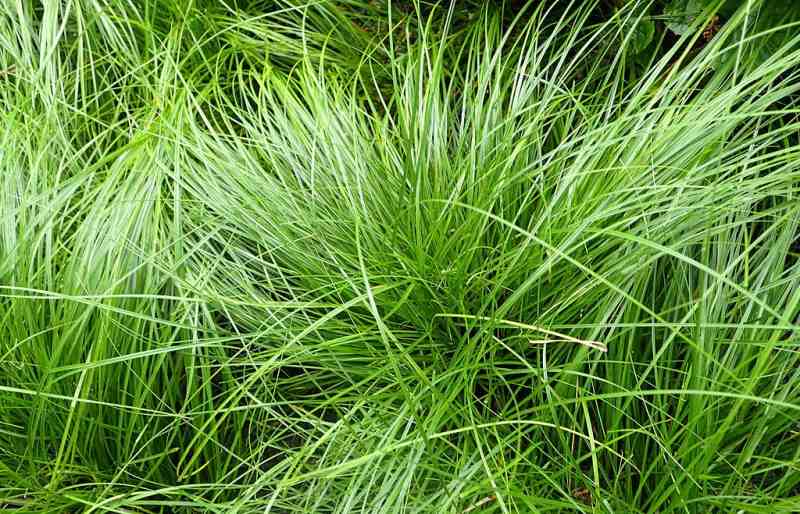
Photo Credit: Krzysztof Ziarnek, Kenraiz / Wikimedia Commons / CC BY-SA 4.0
Opt for a low-maintenance groundcover with the versatile Pennsylvania sedge, a native grass-like plant found throughout the state. Adaptable to various soil conditions and shade levels, this evergreen sedge is perfect for homeowners looking to fill in areas under trees or create a lush, natural look in their gardens. As an added bonus, Pennsylvania Sedge is deer-resistant, ensuring its beauty remains untouched.
Plant type: Grass/Grass-like
USDA Hardiness Zone: 3 to 8
Sun: Full sun, partial shade, full shade
Soil: Adaptable; dry to moist soils
Duration: Perennial
Bloom time: May to July
Water needs: Low
Mature height: Up to about 10 inches tall
Maintenance: Low
3. Swamp Milkweed (Asclepias incarnate)
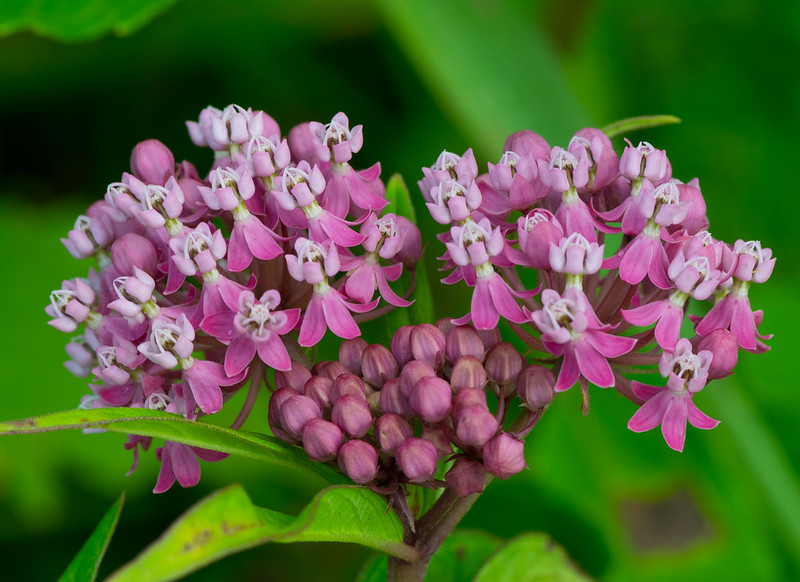
Photo Credit: Joshua Mayer / Flickr / CC BY-SA 2.0
Swamp milkweed, commonly found throughout the state, is an attractive perennial that produces clusters of pink flowers during the summer. Ideal for wetland areas or rain gardens, this native plant is a wonderful choice for homeowners looking to support local ecosystems while adding a touch of color to their landscape.
Swamp milkweed not only adds charm to homeowners’ gardens but also serves as a crucial host for Monarch butterflies and a nectar source for various pollinators.
Plant type: Flower
USDA Hardiness Zone: 3a to 6b
Sun: Full sun
Soil: Prefers clay soil
Duration: Perennial
Fragrance: Vanilla
Bloom time: June to October
Water needs: High
Mature height: 3 to 5 feet
Potential hazards: Poisonous to people, pets, and livestock if ingested.
Maintenance: Low
4. Virginia Bluebells (Mertensia virginica)
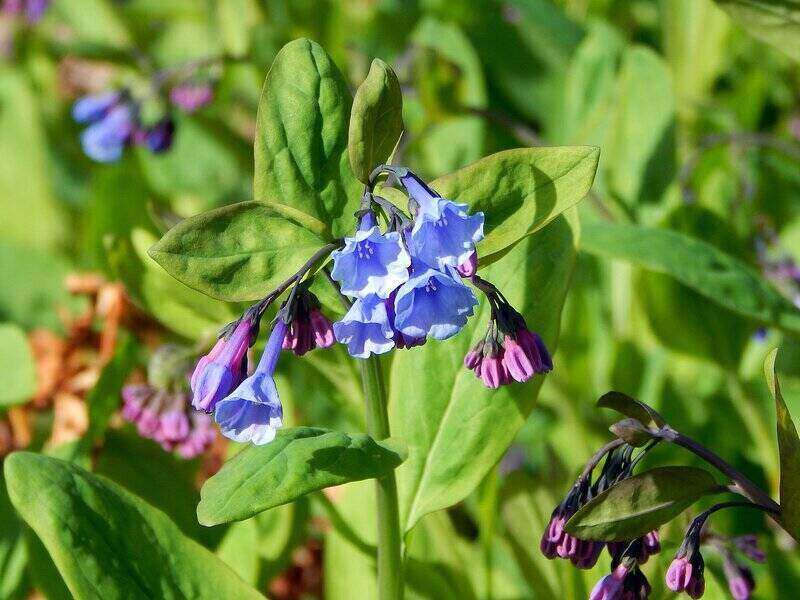
Photo Credit: Khan “Sadh” N. Mostafa / Wikimedia Commons / CC BY 2.0
Virginia Bluebells are charming woodland wildflowers that feature delicate, trumpet-shaped blue flowers in spring. These captivating blooms offer homeowners in the area a delightful splash of color, perfect for brightening up shaded garden spots. Their graceful appearance makes them a charming, low-maintenance addition to any Pennsylvania landscape.
Plant type: Herb
USDA Hardiness Zone: 3 to 8
Sun: Partial shade to full shade
Soil: Chalk, clay, loam, sand; acid, alkaline, neutral; moist but well-drained soils
Duration: Perennial
Fragrance: Light and Sweet
Bloom time: March to June
Water needs: Moderate
Mature height: 1 to 2 feet
Potential hazards: Toxic to humans, dogs, horses, and cattle; can be fatal when consumed in large amounts
Maintenance: Low
5. Wild Bergamot (Monarda fistulosa)
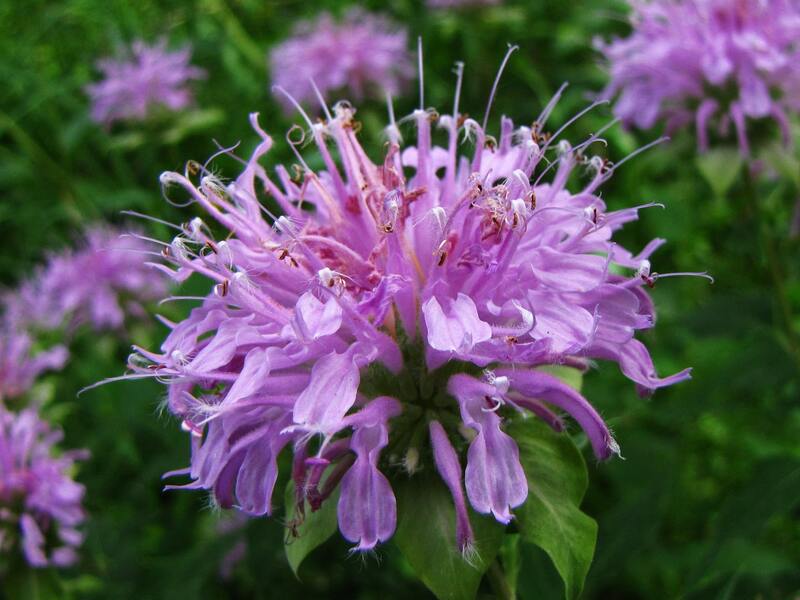
Photo Credit: U.S. Fish and Wildlife Service Headquarters / Flickr / CC BY 2.0
Add a touch of charm to your Pennsylvania garden with wild bergamot, also known as bee balm. This delightful native plant attracts pollinators like bees and butterflies, while offering fragrant foliage and lovely lavender flowers. Easy to grow and low-maintenance, wild bergamot is a perfect addition to your landscape. It’s also drought-tolerant and deer-resistant, making it a popular choice among homeowners in the area.
Plant type: Flower
USDA Hardiness Zone: 3 to 9
Sun: Full sun to partial shade
Soil: Shallow, rocky soil or clay that’s moist, well-drained, or dry-ish
Duration: Perennial
Fragrance: Mint and Oregano
Bloom time: May to October
Water needs: Natural rainfall should be sufficient; withstands dry soil for a while
Mature height: 2 to 4 feet
Potential hazards: Moderately flammable
Maintenance: Low
6. Black-eyed Susan (Rudbeckia hirta)
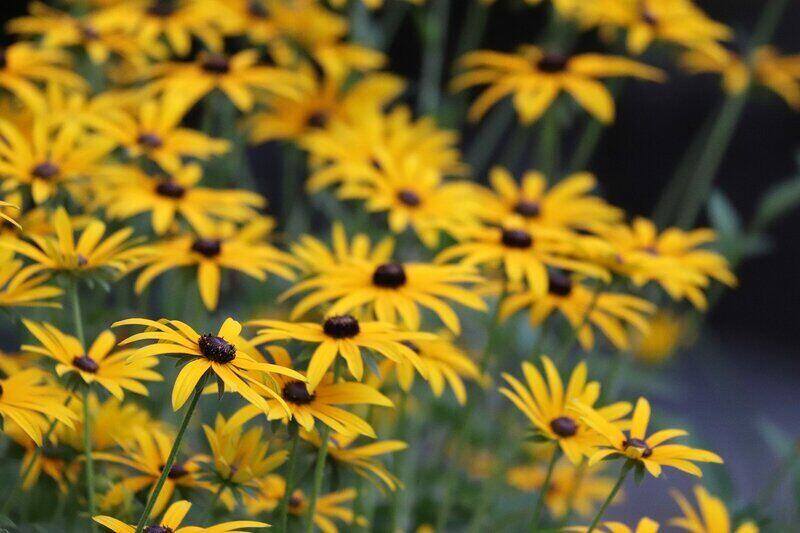
Photo Credit: Pixabay
Black-eyed susan a hardy native plant that thrives in Pennsylvania. Its bright yellow petals surrounding a dark central cone make it an eye-catching addition to any garden. Loved by pollinators and resistant to pests, this low-maintenance beauty is perfect for homeowners looking to add a splash of color without too much fuss.
Plant type: Flower
USDA Hardiness Zone: 3 to 9
Sun: Full sun
Soil: Clay, sand, loam, acidic, moist, well-drained
Duration: Biennial, annual, or short-lived perennial
Fragrance: Sweet
Bloom time: March to November
Water needs: Medium
Mature height: 1 to 3 feet
Maintenance: Low
7. New England Aster (Symphyotrichum novae-angliae)
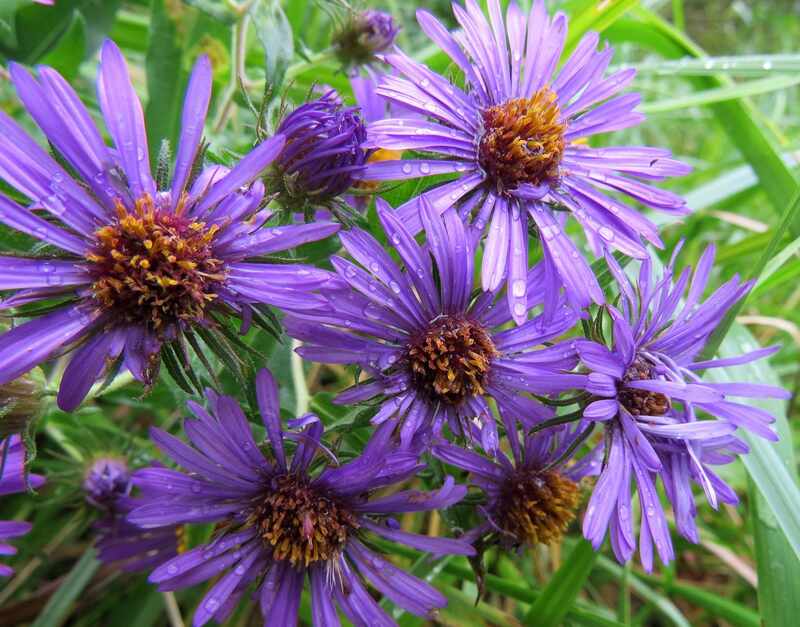
Photo Credit: USFWS Midwest Region / Flickr / Public Domain
Enhance your Pennsylvania garden with the vibrant New England aster. Its rich purple blooms, which attract butterflies and bees, add a stunning pop of color to your landscape. Not only is this plant drought-tolerant, but it also boasts pest resistance, making it an ideal choice for eco-conscious homeowners who want to support local pollinators.
Plant type: Flower
USDA Hardiness Zone: 4a to 8b
Sun: Full sun to partial shade
Soil: Sandy, loamy, clay
Duration: Perennial
Bloom time: August to November
Water needs: Medium
Mature height: 3 to 6 feet
Maintenance: Low
8. Wreath Goldenrod (Solidago caesia)
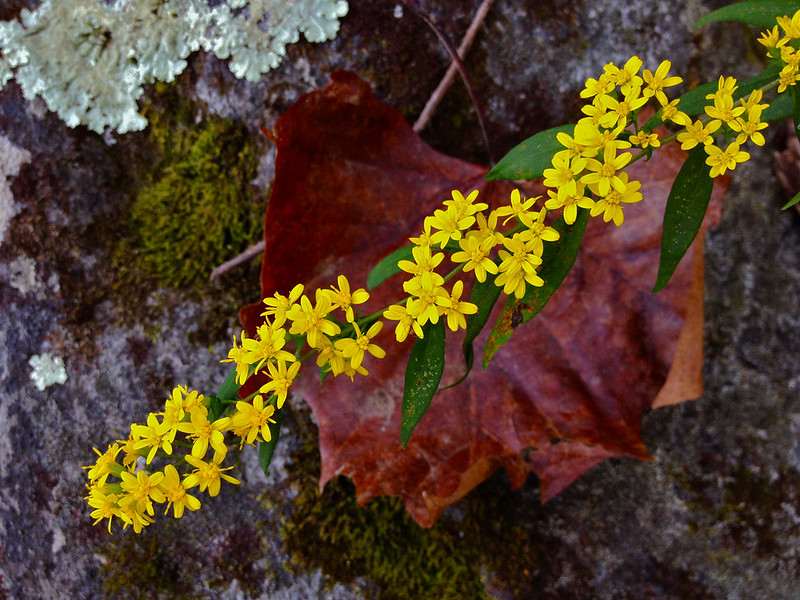
Photo Credit: Fritz Flohr Reynolds / Flickr / CC BY-SA 2.0
Wreath goldenrod, native across Pennsylvania, is a native plant known for its hardiness and adaptability. Showcasing brilliant yellow flowers, this drought-tolerant beauty is a favorite among pollinators and an excellent choice for homeowners seeking low-maintenance landscaping options. With its pest-resistant properties, wreath goldenrod is perfect for gardens across the Keystone State.
Plant type: Herb
USDA Hardiness Zone: 4 to 8
Sun: Full sun to partial shade
Soil: Well-drained acidic and neutral soils
Duration: Perennial
Fragrance: Aniche
Bloom time: August to October
Water needs: Low to Medium
Mature height: 1 to 3 feet
Maintenance: Low
9. Cardinal Flower (Lobelia cardinalis)
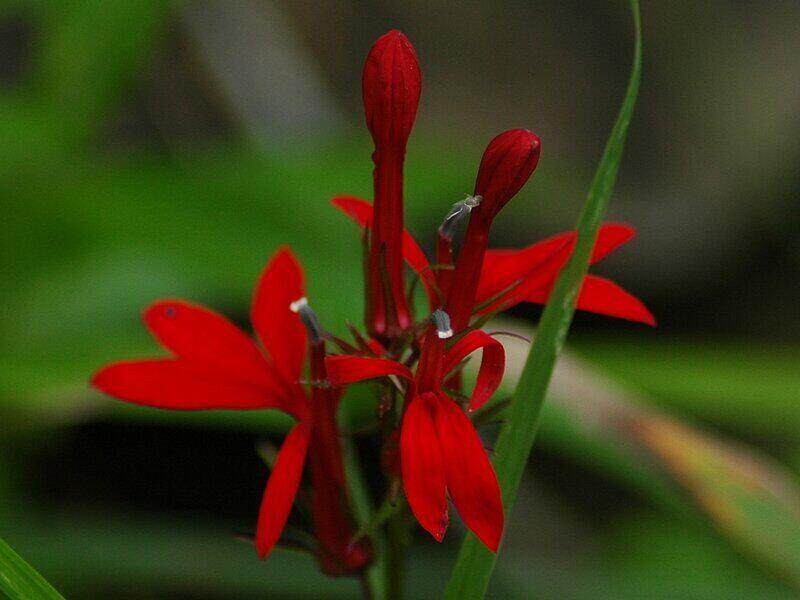
Photo Credit: linnaeus / Wikimedia Commons / CC BY 3.0
Add a burst of red to your landscape with the stunning cardinal flower, a native plant that thrives in Pennsylvania. Known for attracting hummingbirds and butterflies, this vibrant perennial offers both visual appeal and ecological benefits. Homeowners will appreciate its resistance to pests and deer, making it a lovely addition to gardens in the region.
Plant type: Flower
USDA Hardiness Zone: 3 to 9
Sun: Full sun, partial shade, full shade
Soil: Sand, loam, clay, limestone-based
Duration: Perennial
Bloom time: Late summer
Water needs: Moderate to high
Mature height: Up to 6 feet tall
Potential hazards: Toxic to humans and animals if eaten.
Maintenance: Low
10. Heartleaf Foamflower (Tiarella cordifolia)
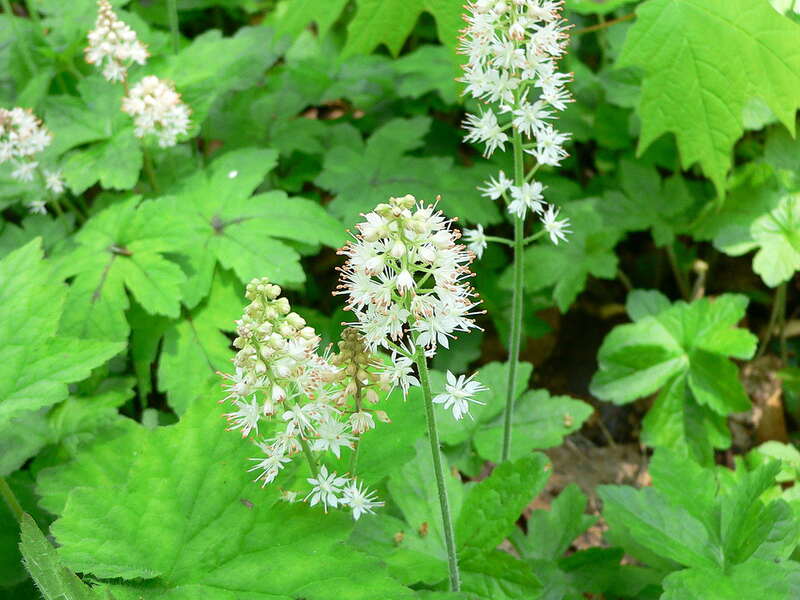
Photo Credit: Raul654 / Wikimedia Commons / CC BY-SA 3.0
Create a woodland haven in your Pennsylvania garden with the delicate heartleaf foamflower. Its lovely white flowers, resembling a frothy foam, provide a unique visual interest, while its shade-tolerance makes it ideal for homeowners with shaded yards. This low-maintenance beauty is also deer-resistant, ensuring its delicate charm remains unharmed.
Plant type: Herb
USDA Hardiness Zone: 3 to 8
Sun: Partial shade to full shade
Soil: Moist, hummus-rich, well-drained soil
Duration: Perennial
Bloom time: March to July
Water needs: Medium
Mature height: Up to about 16 inches tall
Maintenance: Low
11. Butterfly Milkweed (Asclepias tuberosa)
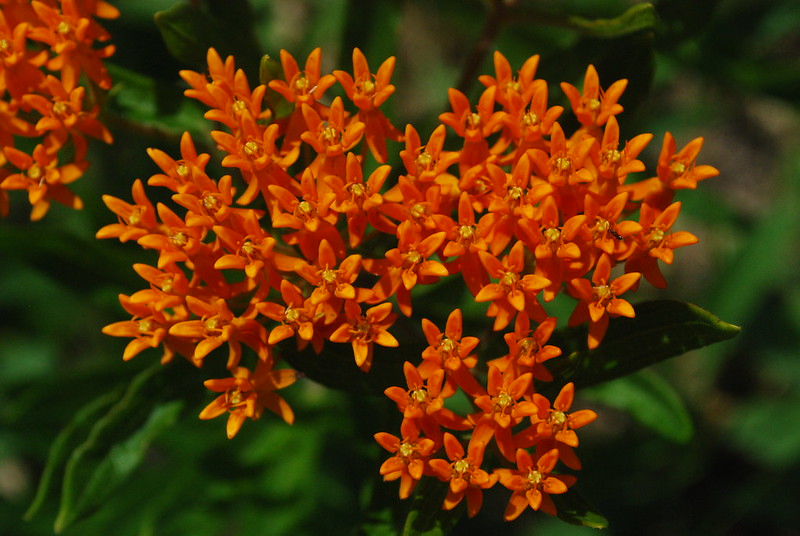
Photo Credit: Joshua Mayer / Flickr / CC BY-SA 2.0
Attract butterflies to your Pennsylvania garden with the aptly named butterfly milkweed. This native plant, with its brilliant orange blooms, provides an important food source for Monarch butterflies and other pollinators. Not only is it drought-tolerant, but it’s also deer-resistant, making it an ideal addition to gardens in Southern Pennsylvania.
Plant type: Herb
USDA Hardiness Zone: 3 to 9
Sun: Full sun
Soil: Clay, loam, and sandy soils
Duration: Perennial
Fragrance: Vanilla
Bloom time: May to September
Water needs: Low
Mature height: 1 to 2 feet
Potential hazards: Toxic to people, pets, and other animals.
Maintenance: Low
12. Blazing Star (Liatris spicata)
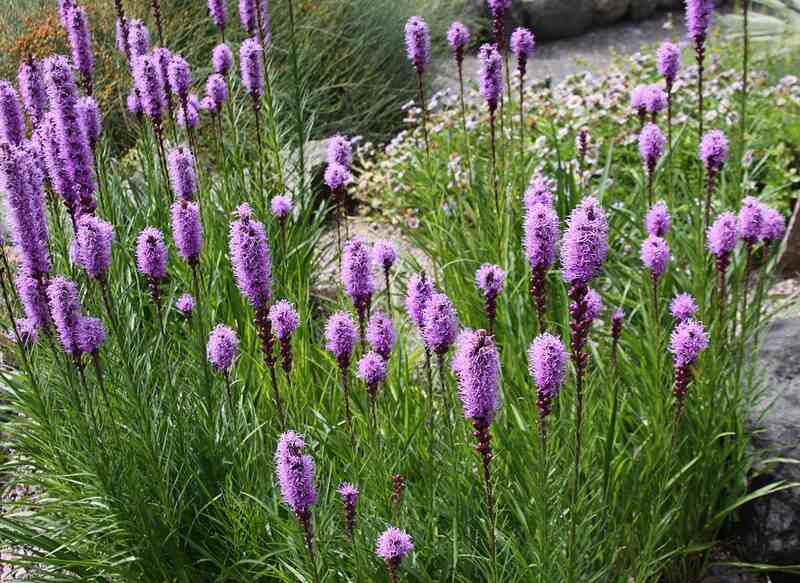
Photo Credit: Drew Avery / Wikimedia Commons / CC BY 2.0
Blazing star, also known as gayfeather, is a native perennial that produces tall spikes of vibrant purple flowers that bloom mostly in the Southeast Pennsylvania Region. This striking plant attracts bees, butterflies, and hummingbirds, making it a valuable addition to pollinator gardens. Its low-maintenance, pest-resistant beauty is perfect for homeowners looking to add a touch of the wild to their outdoor spaces.
Plant type: Flower
USDA Hardiness Zone: 3 to 9
Sun: Full sun to partial shade
Soil: Moist clay, silt, or sandy soil that’s well-drained
Duration: Perennial
Bloom time: July to November
Water needs: Low
Mature height: Up to 6 feet tall
Maintenance: Low
How to Choose Native Plants for Your Pennsylvania Landscape
Ready to pick the perfect native plants for your Pennsylvania garden? First, consider your outdoor space’s unique needs. Here’s an easy guide to help you make the best choices:
- Follow the sun: Watch your garden during different times of the day and note which areas get full sun, partial shade, or full shade. Remember, native plants grow best when they feel right at home in their natural habitat conditions.
- Get to know your soil: Test your soil to find out its composition. Armed with this knowledge, you’ll be able to pick the native plants that’ll thrive in your garden’s soil type.
- Check the drainage and moisture: Take a closer look at your garden’s drainage system and the moisture levels in your soil. This info will steer you towards plants that can happily grow in your garden’s unique environment.
Additionally, it’s important to remember that Pennsylvania falls within USDA Hardiness Zones 5 to 7, so keep this in mind when choosing plants that can handle the local climate. By paying attention to these details, you can create a vibrant, low-maintenance garden filled with Pennsylvania native plants that’ll make your landscape truly shine.
FAQ About Native Pennsylvania Plants
Which native plants are best suited for cities like Philadelphia and Pittsburgh?
Both Philadelphia and Pittsburgh fall within USDA Hardiness Zones 6 and 7. Some native plants well-suited for these cities include eastern redbud, virginia bluebells, and pennsylvania sedge.
What native plants would work well in the Southeastern Pennsylvania region?
In Southeastern Pennsylvania, homeowners can create a vibrant garden with native plants like Swamp Milkweed to attract butterflies and wild bergamot for a lovely fragrance.
What plants are native to the West Pennsylvania region?
For a welcoming backyard in Western Pennsylvania, consider planting heartleaf foamflower for cheerful blooms, wreath goldenrod for a pop of color, and black-eyed Susan to create a lush, attractive landscape that supports local wildlife.
Other native plants of Western Pennsylvania include:
- Eastern Redbud
- Red Columbine
- New England Aster
- Swamp Milkweed
- Butterfly Weed
- Scarlet Beebalm
- Cardinal Flower
Where to Find Native Plants in Pennsylvania
Ready to create a stunning Pennsylvania garden filled with native plants? With options ranging from eye-catching wildflowers and stunning trees to resilient grasses and easy-to-care groundcovers, there’s a native plant for every garden style and taste. Begin your journey by checking out local native plant suppliers found in the Pennsylvania Department of Conservation & Natural Resources website.
Embracing native plants is just one of the many low-maintenance landscaping options for Pennsylvania residents. To further elevate your outdoor space, explore the best grass types for your region to complement your new native plants.
To keep your landscape and the surrounding greenery in tip top shape, hire a lawn care professional near you who can handle the yard’s mowing, trimming, and edging. We have trusted pros throughout Pittsburgh, Philadelphia, and many other cities across the state.
Main Image Credit: Joshua Mayer / Flickr / CC BY-SA 2.0